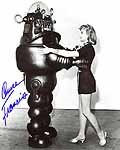MURFREEBORO, Tenn. Science fiction author Andre Norton, who wrote the popular "Witch World" series of books, died today at her home in Murfreesboro. She was 93. Her death was announced by friend Jean Rabe, who said Norton died of congestive heart failure.
Norton was born Alice Mary Norton on February 17th, 1912 in Cleveland. She penned more than 130 novels during her career of nearly 70 years.
The "Witch World" series, which detailed life on a planet reachable only through metaphysical gateways, included more than 30 novels.
Her last complete novel, "Three Hands of Scorpio," is set to be released next month.
The Science Fiction and Fantasy Writers of America recently created the Andre Norton Award for young adult novels, and the first award will be presented in 2006.
Rabe says Norton requested before her death that she not have a funeral service.
Copyright 2005 Associated Press.
If you are a baby boomer there were two juvenile authors of science fiction and fantasy you read. One was R. A. Heinlien the other was Andre Norton. Her asexual nom de plume allowed her to be published at a time when SF was dominated by men.
"It was when she published her first novel that Ms. Norton began to legally use the name Andre, and she has continued to use it exclusively. Thus, the citation of "Andre" as a pseudonym for her given name, Alice Mary, in a number of bibliographies, biographies, and critical accounts is in error. This name change was implemented primarily because she expected to be writing for young boys, and she felt that the change would increase the marketability of her work in this traditionally male market. This was an added asset when she entered the masculine-dominated science-fiction field." Andre Norton Biography By Roger C. Schlobin
I was one of those boys who became an Andre Norton fan. It was when I was in elementary school I discovered her science fiction Witch World series. I continued to read her through out my school years, and became an avid SF and Fanatasy fan. It was her writing style, that was clear and crisp, that inspired me to become a writer, not one of fiction but of journalism.
I also read the Mary Norton's (no relation) Borrowers Series, and the wonderfully wistful and strange The Red Planet, whose chapter title illustrations made Martians look like onions rather than little green men. But it was Andre Norton's voluminous writings that kept me entranced, through out my elementary and junior high years, even after I found Sherlock Holmes, the works of Edgar Alan Poe, and Donald Wolhiem.
Her passing at such an old age, and with such a large literary output is astonishing. She had just finished another novel which was being prepared for publishing when she passed away.
She influenced me and many young readers with her wonderous tales, and we ended up wanting more. She produced for my generation, novels on par with Harry Potter for this generation. And like Rowling, she never talked down to her readers.
She was a feminist, in the sense that she developed strong female characters in her novels, they taught us about egaltarian relations through the medium of fantasy and SF. Her books allowed both boys and girls to see that we could go beyond gender stereotypes to be whatever we wanted to be.
Her love of cats came through in many of her novels, and certainly over the years I have learned that joy of living and communing with our feline companions. Again a subtle influence of her writing in my life.
And her work is not dated, I hope that a new generation of readers inspired by Harry Potter will avail themselves of her books. In a publishing industry today, that is flooded with commercial fantasy novels written for profit rather than any literary value, her works still stand out and stand the test of time.
So long Alice/Andre you have spoken to the imagination of generations, we will always remember you and be grateful for the worlds you opened to us.
Her last complete novel, "Three Hands for Scorpio," .
Norton's publisher, Tor Books, rushed to have one copy printed so that the author, who had been sick for almost a year, could see it. "She was able to hold it on Friday," Jewell said. "She took it and said, 'What a pretty cobalt blue for the cover." Although several more collaborations are scheduled for printing, Three Hands for Scorpio is Andre's last novel written solely on her own. Her last legacy. As you know, Andre has requested that she be cremated with a copy of her first and last book, the alpha and omega. This book will be one of them.







